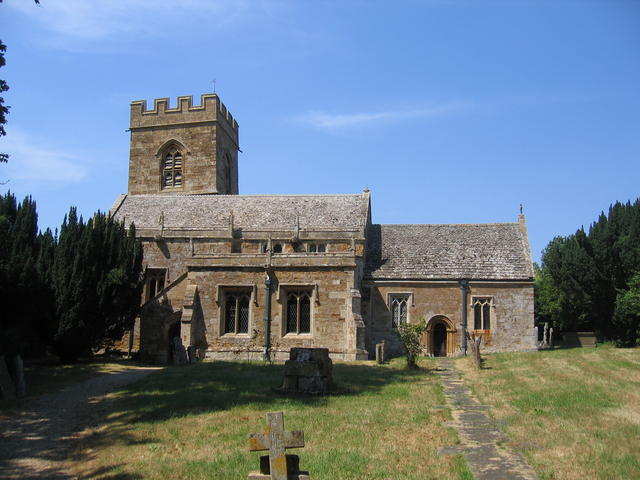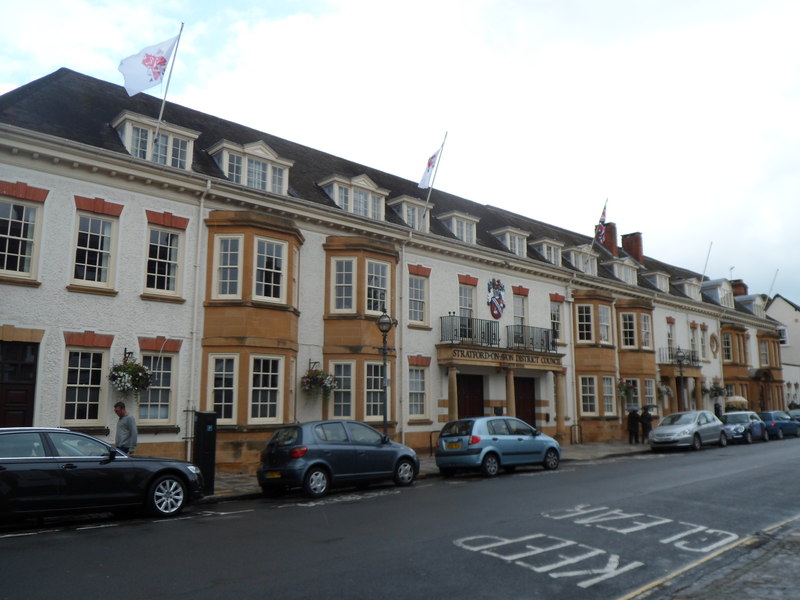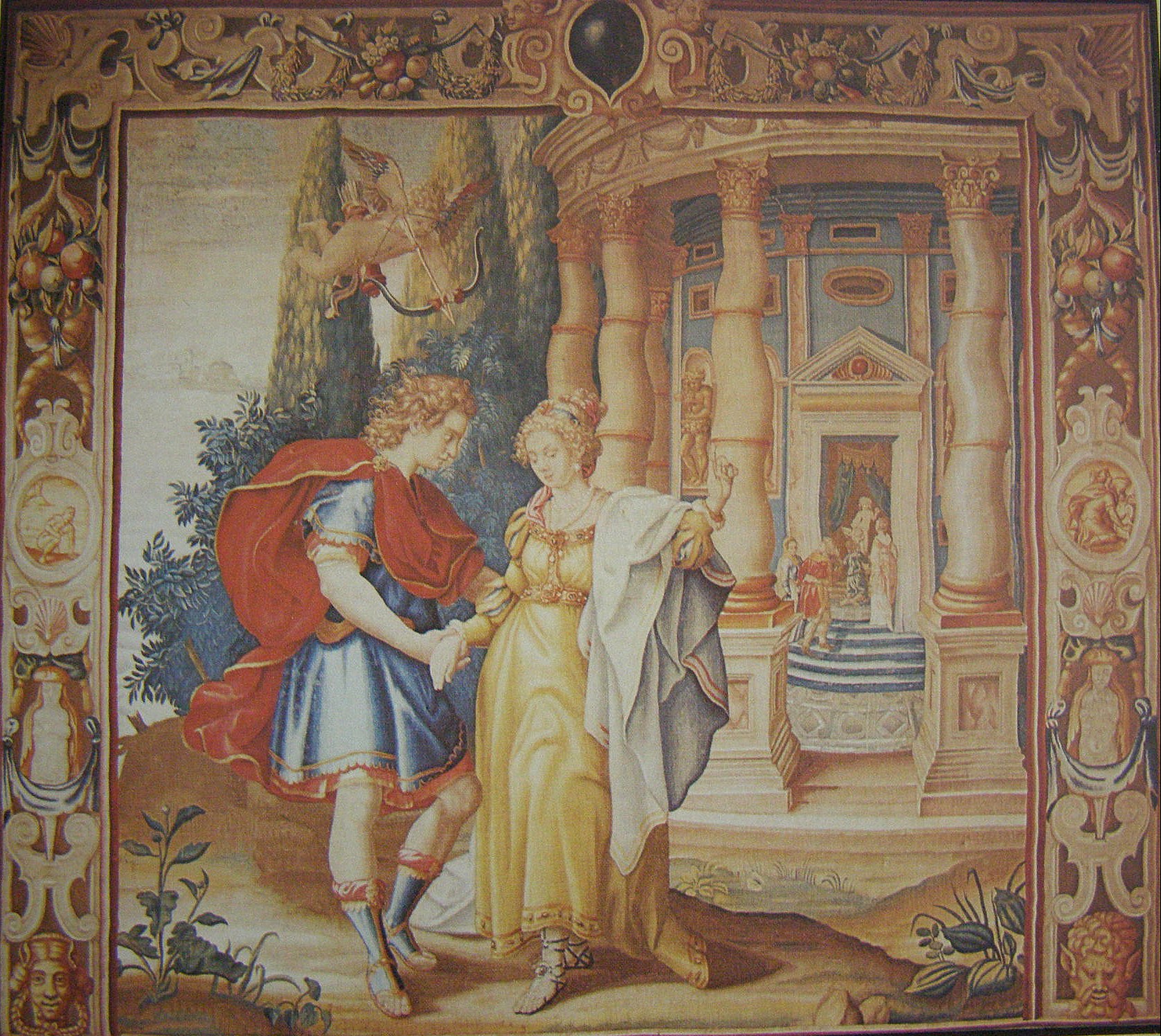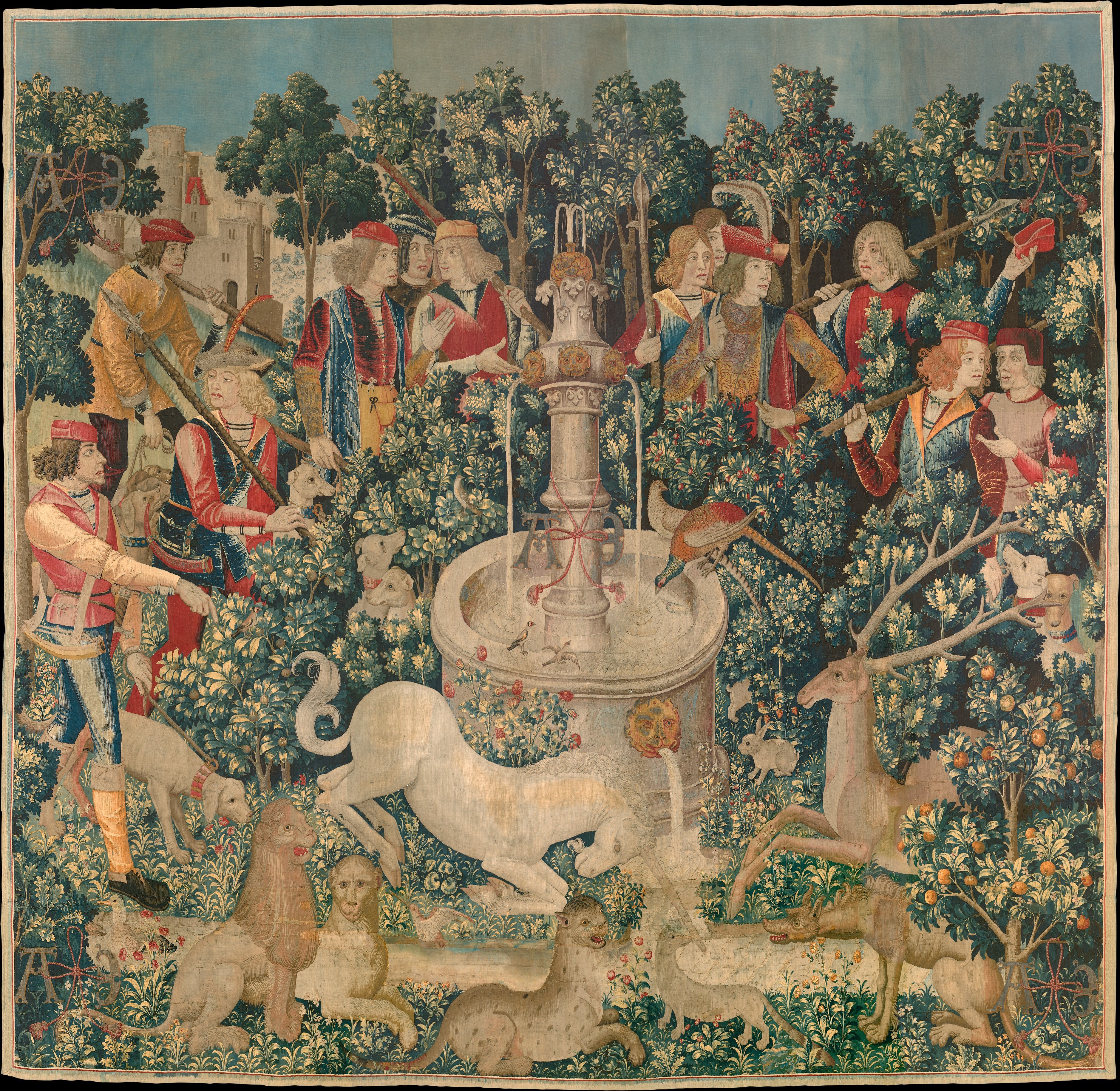|
Barcheston
Barcheston is a village and civil parish in the Stratford-on-Avon district of Warwickshire, England. The village is on the east bank of the River Stour, opposite Shipston-on-Stour. It shares a parish council with Willington. The parish, administered at its lowest level by the Barcheston and Willington Parish Meeting, is in the Ettington ward of the district council. According to the 2001 Census the parishes population was 134, increasing to 141 at the 2011 Census. Ralph Ardern inherited the manor of Barcheston between 1382 (the death of his father, Henry de Ardern) and 1408 (the death of his mother). Whether or not he was ever resident is unknown. The first English tapestry factory was the Sheldon looms, established here in Warwickshire by William Sheldon about the middle of the 16th century. The Sheldon tapestries produced here compare well with the finest contemporary Flemish weavings. Some of these consisted of large tapestry maps of English counties. An outline of Barch ... [...More Info...] [...Related Items...] OR: [Wikipedia] [Google] [Baidu] |
Sheldon Tapestries
Sheldon tapestries were produced at Britain's first large tapestry works in Barcheston, Warwickshire, England, established by the Sheldon family. A group of 121 tapestries dateable to the late 16th century were produced. Much the most famous are four tapestry maps illustrating the counties of Gloucestershire, Worcestershire, Oxfordshire and Warwickshire, with most other tapestries being small furnishing items, such as cushion covers. The tapestries are included in three major collections: the Victoria and Albert Museum, London; the Metropolitan Museum of Art, New York; and the Burrell Collection, Glasgow, Scotland (still uncatalogued). Pieces were first attributed in the 1920s to looms at Barcheston, Warwickshire by a Worcestershire antiquary, John Humphreys, without clear criteria; on a different, but still uncertain basis, others were so classified a few years later. No documentary evidence was then, or is now, associated with any tapestry, so no origin for any piece is defini ... [...More Info...] [...Related Items...] OR: [Wikipedia] [Google] [Baidu] |
Ralph Ardern
Ralph Ardern, or Ralph de Ardern (c. 1374 – c. 1420), was Member of Parliament for Worcestershire from March 1406. He was the son of Henry de Ardern who had previously held the seat in November 1381. He died sometime before 28 October 1420.Driver, J. T. ''Worcestershire Knights of the Shire 1377-1421'' Transactions of the Worcestershire Archaeological Society. Third Series Vol 4 1974 p20 He was a Deputy High Sheriff of Worcestershire from 4 November 1404 to 27 November 1405. Some time between the death of his father, Henry de Ardern in 1382 and the death of his mother in 1408 Ralph Ardern inherited the manors of Little Inkberrow and Wyke Sapy in Worcestershire and Barcheston, Park Hall near Castle Bromwich, Peddimore and property at Curdworth and Sutton Coldfield in Warwickshire Warwickshire (; abbreviated Warks) is a county in the West Midlands region of England. The county town is Warwick, and the largest town is Nuneaton. The county is famous for being the birthp ... [...More Info...] [...Related Items...] OR: [Wikipedia] [Google] [Baidu] |
Stratford-on-Avon (district)
Stratford-on-Avon is a local government district in southern Warwickshire, England. The district is named "Stratford-on-Avon" unlike its main town of Stratford-upon-Avon where the district council is based. The district is mostly rural and covers most of the southern half of Warwickshire. As well as Stratford, other significant places in the district includes the towns of Alcester, Southam, Shipston-on-Stour and Henley-in-Arden, and the large villages of Bidford-on-Avon, Studley and Wellesbourne, plus numerous other smaller villages and hamlets. It borders the Warwickshire districts of Warwick to the north, and Rugby to the north-east. It also borders the neighbouring counties of the West Midlands, Worcestershire, Gloucestershire, Oxfordshire, and Northamptonshire. History The district was formed on 1 April 1974 under the Local Government Act 1972 by the merger of the municipal borough of Stratford-upon-Avon, Alcester Rural District, Shipston-on-Stour Rural District ... [...More Info...] [...Related Items...] OR: [Wikipedia] [Google] [Baidu] |
Willington, Warwickshire
Willington is a village in Warwickshire, England. Population details are included within Barcheston. The origin of the place-name is from Old English ''tun'' (homestead or farm) of Wulfāf's (or Wīglāf's) people. It appears as ''Ullavintone'' in the Domesday Book Domesday Book () – the Middle English spelling of "Doomsday Book" – is a manuscript record of the "Great Survey" of much of England and parts of Wales completed in 1086 by order of King William I, known as William the Conqueror. The manusc ..., and as ''Wullavington'' in 1287. References External links Villages in Warwickshire {{Warwickshire-geo-stub ... [...More Info...] [...Related Items...] OR: [Wikipedia] [Google] [Baidu] |
The Leaning Tower Of Barcheston - Geograph
''The'' () is a grammatical article in English, denoting persons or things that are already or about to be mentioned, under discussion, implied or otherwise presumed familiar to listeners, readers, or speakers. It is the definite article in English. ''The'' is the most frequently used word in the English language; studies and analyses of texts have found it to account for seven percent of all printed English-language words. It is derived from gendered articles in Old English which combined in Middle English and now has a single form used with nouns of any gender. The word can be used with both singular and plural nouns, and with a noun that starts with any letter. This is different from many other languages, which have different forms of the definite article for different genders or numbers. Pronunciation In most dialects, "the" is pronounced as (with the voiced dental fricative followed by a schwa) when followed by a consonant sound, and as (homophone of the archaic p ... [...More Info...] [...Related Items...] OR: [Wikipedia] [Google] [Baidu] |
Villages In Warwickshire
A village is a clustered human settlement or community, larger than a hamlet but smaller than a town (although the word is often used to describe both hamlets and smaller towns), with a population typically ranging from a few hundred to a few thousand. Though villages are often located in rural areas, the term urban village is also applied to certain urban neighborhoods. Villages are normally permanent, with fixed dwellings; however, transient villages can occur. Further, the dwellings of a village are fairly close to one another, not scattered broadly over the landscape, as a dispersed settlement. In the past, villages were a usual form of community for societies that practice subsistence agriculture, and also for some non-agricultural societies. In Great Britain, a hamlet earned the right to be called a village when it built a church. [...More Info...] [...Related Items...] OR: [Wikipedia] [Google] [Baidu] |
Mortlake Tapestry Works
The Mortlake Tapestry Works was established alongside the River Thames at Mortlake, then outside, but now on the edge of west London, in 1619 by Sir Francis Crane. It produced lighter, if vastly more expensive, decoration for rooms than the previously favoured Elizabethan wood panelling. King Charles I was a heavy investor and it prospered. The English Civil War disrupted all luxury goods businesses. Cromwell tried to help. Charles II imposed heavy duties on competitive imports, but the decline could not be reversed. It closed in 1704; some of the weavers continued to work privately. Royal patronage The proposal to establish a tapestry works at Mortlake came from King James I in 1619. It was to be under the management of Sir Francis Crane who undertook the recruitment of weavers and to meet the cost of building and fitting up premises. In return he was to receive a fee, the exclusive right to weave tapestries of all sorts for 21 years and they were to be free of customs duties ... [...More Info...] [...Related Items...] OR: [Wikipedia] [Google] [Baidu] |
Victoria County History
The Victoria History of the Counties of England, commonly known as the Victoria County History or the VCH, is an English history project which began in 1899 with the aim of creating an encyclopaedic history of each of the historic counties of England, and was dedicated to Victoria of the United Kingdom, Queen Victoria. In 2012 the project was rededicated to Elizabeth II, Queen Elizabeth II in celebration of her Diamond Jubilee year. Since 1933 the project has been coordinated by the Institute of Historical Research in the University of London. History The history of the VCH falls into three main phases, defined by different funding regimes: an early phase, 1899–1914, when the project was conceived as a commercial enterprise, and progress was rapid; a second more desultory phase, 1914–1947, when relatively little progress was made; and the third phase beginning in 1947, when, under the auspices of the Institute of Historical Research, a high academic standard was set, and pr ... [...More Info...] [...Related Items...] OR: [Wikipedia] [Google] [Baidu] |
Flemish People
The Flemish or Flemings ( nl, Vlamingen ) are a Germanic ethnic group native to Flanders, Belgium, who speak Dutch. Flemish people make up the majority of Belgians, at about 60%. "''Flemish''" was historically a geographical term, as all inhabitants of the medieval County of Flanders in modern-day Belgium, France, and the Netherlands were referred to as "Flemings", irrespective of their ethnicity or language. The contemporary region of Flanders comprises a part of this historical county, as well as parts of the medieval duchy of Brabant and the medieval county of Loon, where the modern national identity and culture gradually formed. History The sense of "Flemish" identity increased significantly after the Belgian Revolution. Prior to this, the term "Vlamingen" in the Dutch language was in first place used for the inhabitants of the former County of Flanders. Flemish, however, had been used since the 14th century to refer to the language and dialects of both the peoples ... [...More Info...] [...Related Items...] OR: [Wikipedia] [Google] [Baidu] |
Loom
A loom is a device used to weave cloth and tapestry. The basic purpose of any loom is to hold the warp threads under tension to facilitate the interweaving of the weft threads. The precise shape of the loom and its mechanics may vary, but the basic function is the same. Etymology and usage The word "loom" derives from the Old English ''geloma'', formed from ''ge-'' (perfective prefix) and ''loma'', a root of unknown origin; the whole word ''geloma'' meant a utensil, tool, or machine of any kind. In 1404 "lome" was used to mean a machine to enable weaving thread into cloth. By 1838 "loom" had gained the additional meaning of a machine for interlacing thread. Weaving Weaving is done by intersecting the longitudinal threads, the warp, i.e. "that which is thrown across", with the transverse threads, the weft, i.e. "that which is woven". The major components of the loom are the warp beam, heddles, harnesses or shafts (as few as two, four is common, sixteen not unheard of), ... [...More Info...] [...Related Items...] OR: [Wikipedia] [Google] [Baidu] |
Tapestry
Tapestry is a form of textile art, traditionally woven by hand on a loom. Tapestry is weft-faced weaving, in which all the warp threads are hidden in the completed work, unlike most woven textiles, where both the warp and the weft threads may be visible. In tapestry weaving, weft yarns are typically discontinuous; the artisan interlaces each coloured weft back and forth in its own small pattern area. It is a plain weft-faced weave having weft threads of different colours worked over portions of the warp to form the design. Tapestry is relatively fragile, and difficult to make, so most historical pieces are intended to hang vertically on a wall (or sometimes in tents), or sometimes horizontally over a piece of furniture such as a table or bed. Some periods made smaller pieces, often long and narrow and used as borders for other textiles. European tapestries are normally made to be seen only from one side, and often have a plain lining added on the back. However, other tradit ... [...More Info...] [...Related Items...] OR: [Wikipedia] [Google] [Baidu] |
Henry De Ardern
Henry de Ardern, or Henry Ardern, was a Member of Parliament for Warwickshire in 1377 and again in 1380, and for Worcestershire from November 1381. In 1373 Henry bought Park Hall, near Castle Bromwich, from Sir John Botetourt.Driver, J. T. ''Worcestershire Knights of the Shire 1377-1421'' Transactions of the Worcestershire Archaeological Society. Third Series Vol 4 1974 p. 19 In 1377, or 1378, he was granted the manors of Croome Adam (now Earls Croome) and Grafton Flyford by the Earl of Warwick for a red rose. He was the son of Ralph de Ardern and probably born at Curdworth Curdworth is a village and civil parish in the North Warwickshire district of the county of Warwickshire in England. The population taken at the 2011 census was 1,115. Location Curdworth is 11 miles east of the centre of Birmingham. North War .... He died in 1382. He married and had a son, Ralph Ardern who also became the Member of Parliament for Worcestershire in March 1406.Driver, J. T. ''Worces ... [...More Info...] [...Related Items...] OR: [Wikipedia] [Google] [Baidu] |


.png)



